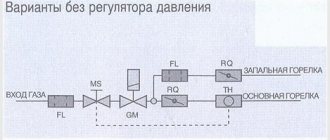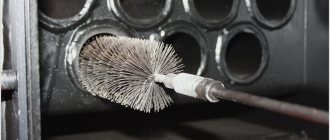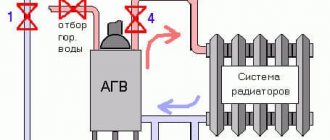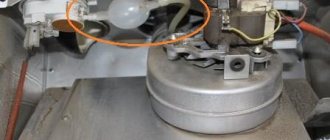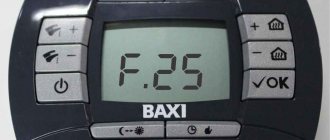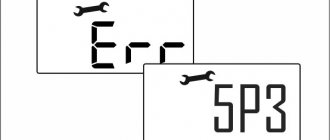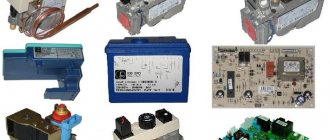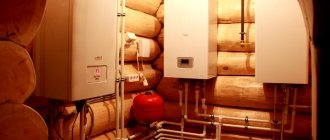Brief information about the system design
A gas heater is a rather complex unit. Its structure is based on the following components and systems:
- a furnace in which fuel combustion occurs;
- air supply and combustion product removal systems;
- a heat exchanger in which a flame heats water or coolant;
- automation systems;
- security systems.
The firebox, or combustion chamber, can be open or closed. In the first case, the air required for fuel oxidation enters the firebox through the air intake on the body from the room in which the unit is installed. Combustion products are removed through a traditional chimney that rises above the roof. The craving is formed naturally.
In a closed chamber, there is no exchange of air between the interior spaces and the heater. Air enters from the street, and exhaust gases are removed back through a horizontal coaxial chimney passing through the wall of the building. A fan is used to create draft.
The heat exchanger may have one or two circuits. The first, closed circuit is connected to the heating system; the coolant circulates in it using a pump. A second circuit can also be installed on a gas boiler; water from the water supply system passes through it and is heated. This circuit is open; water is supplied due to the pressure created by the pumping station.
Automation and safety systems maintain the specified coolant temperature and monitor trouble-free operation of the device. In modern models they are combined into a common computerized control system.
The security group includes the following subsystems:
- draft sensor, when draft falls below a set level, it turns off the gas supply;
- an additional draft sensor in the exhaust channel protects against combustion products entering the room;
- the flame controller monitors the operation of the burner and turns off the supply when the torch goes out;
- an emergency valve relieves coolant pressure if it exceeds a preset value;
- The pressure sensor stops the unit if the pressure and flow rate of the coolant drops below a set value, for example, due to a leak.
Automation and safety systems on boilers with an open chamber and natural circulation of coolant can be mechanical - then the boiler does not require electricity to operate. More advanced and economical boilers require a constant power supply to operate the fan, circulation pump and control system
What can happen to a gas boiler
Here are the most common failures in gas heaters:
- The burner either does not ignite at all, or immediately goes out after ignition.
- The boiler electronics do not work (the display does not light up, the unit does not respond to button presses).
- The boost fan is acting up (in boilers with a closed combustion chamber).
- It is not possible to ignite the igniter: as soon as the user releases the button on the valve, the wick immediately goes out.
- The main burner burns unevenly, popping sounds are heard frequently, and the flame is yellow.
- A double-circuit boiler supplies hot water in a thin stream and often turns off due to overheating.
- The boiler is operating at full capacity, but the coolant temperature does not reach the required values.
A gas boiler consists of many parts, each of which can cause it to break down.
Causes of breakdowns
Gas heaters are considered very reliable devices and rarely fail.
Service center specialists have formulated several main reasons why equipment may fail:
poor water quality
This reason is relevant for double-circuit boilers that supply hot water to the local water supply system. Mineral deposits and rust gradually accumulate in the tubes of the secondary circuit heat exchanger, reducing their cross-section and causing corrosion, up to complete blocking. When water circulation decreases, the heat exchanger connections become overheated and may fail. To prevent such a situation, you should install a mechanical cleaning filter at the inlet of the circuit and periodically change the filter element in it.
Poor water quality is a possible cause of gas boiler failure
quality of power supply
Voltage drops, phase surges, periodic power outages and other manifestations of poor quality power supply lead to the operation of the heater's electrical equipment with overloads, and its components are subject to accelerated wear. Particularly strong voltage surges can lead to their complete failure. To combat low quality power supply, the following methods are used:
- installing a stabilizer will eliminate voltage surges;
- connecting an uninterruptible power supply to a battery will allow you to survive short-term power outages;
- An electric generator with an internal combustion engine will provide power in case of long-term outages.
You should assess the quality of the network in advance, purchase and connect the necessary devices in advance
incorrect installation of equipment
If the unit was installed by an amateur, not all requirements of the installation instructions may be met:
- Lack of grounding (or improper grounding) of the device leads to the accumulation of static charges on the body and chassis and can damage the electronic control system;
- there are air pockets in the heating system, this leads to overheating and damage to heat exchangers and pipelines, the circulation pump may also fail;
- incorrect connection of inlet and outlet pipes, neglect of emergency valves or blocking of their valves can lead to overheating of the coolant and failure of the pipeline system
There are also errors in the installation of a coaxial chimney, as a result it begins to freeze and the draft sensor turns off the boiler.
non-compliance with operating conditions
often occurs among those owners who incorrectly calculated the boiler power and did not provide a 20% reserve for extreme weather conditions. In such houses, during severe frosts or winds, the device operates at maximum power for a long time. The automation will periodically turn off the gas. In addition, such operation leads to its accelerated wear and failure in the midst of cold weather.
Diagnostic nuances
Modern gas fuel heaters are complex technical objects. They are a source of increased danger due to the potential for fire or even gas explosion. This outcome can be caused by neglecting the rules for using the heating system and untimely troubleshooting.
An automatic control system maintains the operation of the boiler in a given mode and ensures the safety of its operation. An inexperienced user will not be able to determine a malfunction in the electronic unit; in this case, you should immediately contact professionals who have sufficient qualifications and the necessary diagnostic equipment.
It is best to entrust the diagnosis of a gas boiler to specialists
With your own hands, it makes sense to eliminate simple faults associated with contamination of individual parts and assemblies, sealing of connections, and poor contacts.
The boiler only operates at low power. ( not warm )
Possible causes of this malfunction:
- Low gas pressure;
- Burner nozzles must be replaced or cleaned.
Ways to resolve this problem:
- Setting the gas valve pressure.
5. The pilot burner goes out after ignition.
Possible malfunctions and repair methods
To eliminate complex breakdowns or malfunctions of gas equipment, it is necessary to involve certified specialists or organizations. In some cases, it is quite possible to carry out minor repairs to a gas boiler yourself.
smell of gas
Most often, gas begins to smell when it leaks from leaks in the threads of the supply pipe. If a characteristic odor is detected, immediately turn off the heater and ventilate the room. For repairs you will need the following materials and tools:
- a thick solution of soap in water;
- gas or adjustable wrench;
- thread sealant - plumbing thread or FUM tape.
You can fix the problem this way:
- lubricate all connections with the solution; soap bubbles will appear and burst at the place where gas leaks;
- turn off the gas supply;
- unscrew the liner;
- wrap the sealant around the thread, carefully tighten the connection until it stops, but do not overtighten;
- open the gas supply;
- re-lubricate the connection with soapy water; make sure there are no bubbles.
If they continue to appear, immediately turn off the supply and contact the gas specialists.
fan doesn't work
If the usual tone of the fan operation changes, extraneous sounds appear, or if there are no sounds at all, we can confidently assume that the fan has failed.
To fix the problem you will need:
- crosshead screwdriver;
- replacement bearing;
- rags;
- CIATIM type grease.
Repairs are carried out in the following sequence:
- disconnect the device from the network, turn off the gas supply;
- remove the fan;
- Use a rag to remove dirt from the blades;
- if the fan parts, such as the coil or contact groups, are darkened or melted, the fan will have to be replaced;
- remove the fan casing; inspect the bearing.
If it fails, replace it with a new one, not forgetting to lubricate it.
Another reason for fan malfunctions may be instability of power supply parameters. In this case, you should purchase a voltage stabilizer of appropriate power and connect the boiler through it.
If interruptions in the operation of the fan are caused by a malfunction of the control system, it is necessary to involve professionals to repair the gas boiler board.
high temperatures
Exceeding the temperature is most often caused by contamination of the heat exchangers and a decrease in their ability to remove thermal energy from the firebox.
To correct the situation you will need:
- hydrochloric acid solution;
- stiff wire brush;
- gas or open-end wrench;
- thread sealant.
Cleaning the heat exchanger is carried out in the following sequence:
- turn off the gas and electricity supply to the unit;
- close the valves connecting to the heating system pipelines
- Use a wrench to carefully unscrew the heat exchanger;
- remove carbon deposits and other contaminants with a wire brush;
- gradually pour hydrochloric acid into the radiator through the pipe; the appearance of foam indicates severe contamination of the pipes with scale;
- let the acid drain, repeat the operation;
- Rinse the heat exchanger with plenty of water.
Now you can mount it back, not forgetting to wrap the threaded connections with a sealant.
When working with acid solutions, be careful and be sure to use personal protective equipment: acid-resistant gloves and safety glasses, or a clear face shield.
If leakage of coolant from the pipes is detected, you must contact a workshop to repair the gas boiler heat exchanger.
sensor malfunction
A common malfunction is the erroneous operation of the burner flame sensor. A characteristic sign of such a malfunction is the fading of the torch a few seconds after ignition. On devices with a self-diagnosis option, the corresponding error code is displayed on the display.
To fix the problem, turn off the gas and electricity supplies. Next, apply thin sandpaper to the electrode contacts without removing the sensor from the boiler. If cleaning does not produce results, the part will have to be replaced.
The draft sensor should be removed from the device, washed with an alcohol solution and blown with compressed air to dry it completely. If this does not help, you should contact a professional.
settings failure
Sometimes you can try to fix a control system malfunction by resetting the settings to factory values. The combination and duration of pressing the control buttons for this operation is given in the user manual. If after resetting the unit does not work, you should call specialists.
the chimney is clogged
Chimney blockage occurs in floor-standing gas boilers with an open combustion chamber. The quality of traction is checked as follows:
- turn off the gas supply;
- open a revision;
- in a metal container, bring a piece of paper to the audit and set it on fire;
- if the leaf is not pulled into the chimney, but smoke goes into the room, the draft is insufficient and the chimney is clogged.
It is better to call professional chimney sweeps to clean your chimney.

